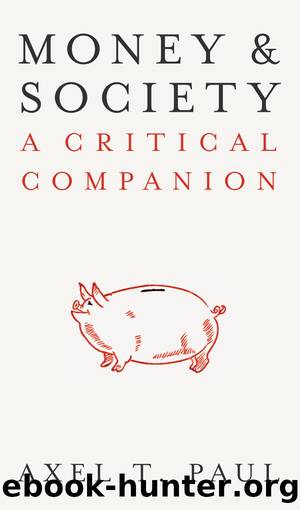Money and Society by Axel T. Paul

Author:Axel T. Paul [Paul, Axel T.]
Language: eng
Format: epub
ISBN: 9780745341965
Google: h9B0zQEACAAJ
Publisher: Pluto Press
Published: 2020-11-20T05:28:23+00:00
_________________
1. Translatorâs note: in German Handlungsorientierungen.
2. Translatorâs note: Ereignishaftigkeit â being composed of individual events.
3. Translatorâs note: Simmel uses the term Vermögen, which in German means both âcapabilityâ and âwealthâ.
4
The Politics of Money
4.1. THE FOUNDATIONS AND FUNDAMENTAL PROBLEMS OF CONTEMPORARY MONEY
âThis note is legal tender for all debt, public or privateâ â this strange phrase is found on all US dollar bills. By law, the US government stipulates that all tax, financial and legal obligations between private persons and the state, and even those between private persons within its sovereign territory, are to be redeemed in dollars. As long as debts are expressible in monetary terms, the US government guarantees everyoneâs right to pay and definitively settle them through payment in dollars (or, depending on your perspective, the government obliges every person to do so). The same applies to the euro in the eurozone, the franc in Switzerland and the yen in Japan. âRealâ money is what central banks issue in the name of the state, a small percentage of which circulates as cash â that is, in the form of banknotes and coins â while the rest is held by commercial banks, seldom as physical cash reserves, but most commonly as book money reserves (on what follows, see Ingham 2004: 134â51; Huber 2017: 57â100).
Commercial banks can acquire central bank money by indebting themselves to the central bank, for which they must hand over assets with a certain minimum rating to serve as collateral for the loans. By changing the base rate â the interest rate commercial banks must pay to borrow â the central bank affects their demand for central bank money. Central banks can also make central bank money more easily available by being willing to take on more assets, or, conversely, they can reduce its availability by shedding the assets they own. In the latter case, they take back central bank money and thus remove it from circulation within the economy. In principle, central banks thereby have the power to create money âfrom thin airâ, or to put it another way, to âprintâ it at will and to make it disappear again by âdestroyingâ the banknotes they take in. However, this power is constrained by the legal prohibition on certain kinds of open market transactions and by the fact that access to central bank credit depends on commercial banks actually handing over assets as collateral.
The risk inherent in central banks having this unique position â and this is one of the main accusations commonly levied against the present monetary order â is evident: central banks have the capability to introduce more money into circulation than economic actors (producers and consumers) actually need. This would cause inflation, in the sense of a generalised rise in prices, without there being any shortage of goods in supply or any rise in demand, simply because too much money is available. Prices would lose their allocative function and value as communicators of information. The same principle applies to an undersupply of central
Download
This site does not store any files on its server. We only index and link to content provided by other sites. Please contact the content providers to delete copyright contents if any and email us, we'll remove relevant links or contents immediately.
The Fall by Gilly Macmillan(279)
Madame terror by Jan Guillou(262)
De Held by Durlacher Jessica(261)
The Horus Heresy Sammelband X by Chris Wraight(243)
Frontkameraden by Hassel Sven(233)
Columbus Day--Expeditionary Force Band 1 by Craig Alanson(228)
Dukes of Ruin: The Royals of Forsyth U by Lawson Angel & Rue Samantha(212)
Kant by Anthropologie in pragmatischer Hinsicht (9783787324057)(200)
Wolf: Under Your Skin (Wolf series Book 1) by Ellen Hunter(195)
The Horus Heresy: Sammelband VIII by divers Autoren(194)
The Queen Will Rise by Marie Niehoff(186)
Jenna by Julia Stirling(171)
Children of ... 2 - Flammende Schatten by Adeyemi Tomi(162)
Garden of lies by Both Don & O'Hara Maria(161)
Reset by Jens Bühler(160)
SINFULLY MISSED: Dark Mafia Romance by Ambra Kerr(158)
Sinfully Owned by Kerr Ambra(158)
The Labyrinth by Ina Seidel(155)
Dawn of the Dragons by Lara A. Steel(146)
